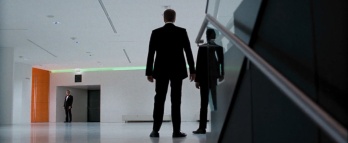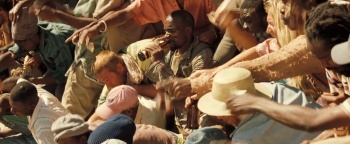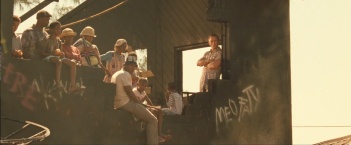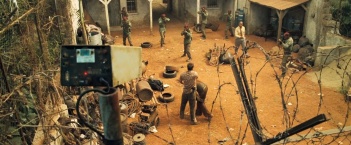 Quantum of Solace currently holds a 65% rating on Rotten Tomatoes, and has the dubious distinction of being the worst Bond movie of the modern era. But is this fair? Is Quantum, the first true sequel in the 50 year history of the franchise, really that bad? I don’t think so. In fact, this will be, by far, the simplest prescription of all.
Quantum of Solace currently holds a 65% rating on Rotten Tomatoes, and has the dubious distinction of being the worst Bond movie of the modern era. But is this fair? Is Quantum, the first true sequel in the 50 year history of the franchise, really that bad? I don’t think so. In fact, this will be, by far, the simplest prescription of all.
Rx: Change the director.
That’s it. I’ve heard people complain about the story, but is it really any worse than any other Bond story? No, the problem is the story telling. Just as a comedian with poor timing can kill a great joke, a director can ruin a great story. Director Marc Foster is a talented and experienced director, but he was the wrong director for Bond.
The shaky cam is something that everyone mentions; I’ve heard Quantum referred to as a “James Bourne” movie–which is fair. Shaky hand-held shots have never been a stylistic hallmark of the series as it has with the Bourne Movies.

But it isn’t just the shaky cam. Foster directs this movie like someone who hates action. Every action sequence is held at arm’s length, the audience separated from what is going on onscreen by several layers of artifice.

 From the very first shot, Foster makes the artistic choice rather than the engaging one. He starts the film with a beautiful wide shot that zooms into the Italian waterside roadway where a car chase is happening. The music slowly builds over extremely muted sounds of the cars, and… gunfire? It’s hard to tell. When the music crescendos, we are hit by a wall of sound as the rest of the soundtrack finally catches up. I would have let this scene go, as it was an effective way of propelling the audience into the film, only he keeps separating the audience from almost every single action sequence in the film in similar ways.
From the very first shot, Foster makes the artistic choice rather than the engaging one. He starts the film with a beautiful wide shot that zooms into the Italian waterside roadway where a car chase is happening. The music slowly builds over extremely muted sounds of the cars, and… gunfire? It’s hard to tell. When the music crescendos, we are hit by a wall of sound as the rest of the soundtrack finally catches up. I would have let this scene go, as it was an effective way of propelling the audience into the film, only he keeps separating the audience from almost every single action sequence in the film in similar ways.







A perfect example is the fight in the opera house. His first level of separation is by having the music of the opera being the only sound during the first part of the chase and fight. The next is by starting off with an excellent establishing shot only to follow up with a series of disorienting close and medium shots that, since the camera is shaking, doesn’t give the audience any sense of direction or indication of what we’re supposed to be focused on. We can’t tell where Bond is going, or who is shooting at whom. Compounding the disorientation, Foster inter-cuts scenes of the opera. Artistic, but, unlike other Bond films, unconnected to the action (compare to this fight scene in Moonraker). This sort of disorientation is perfect for a Bourne movie, where we’re meant to share in Jason’s confusion… but not for a Bond movie where we want to actually enjoy the incredible stunts and fight choreography. The clever ways Bond gets in and out of sticky situations is part of the joy of watching a Bond film, a joy Foster denies us.
Compare this to the spectacular parkuor chase scene at the beginning of Casino Royal.  From the start at the mongoose/cobra fight pit and the wide establishing shot, each
From the start at the mongoose/cobra fight pit and the wide establishing shot, each 














 successive shot is used to expertly inform the viewer of every detail, from the gamblers, to the combatants in the pit (the venomous cobra symbolic of the bomber, and the mongoose of the tough and tenacious 007), to the target, bomb maker Mollaka, to both British agents on scene. Director Martin Campbell expertly switches between a series of close, medium, and wide shots using a combination of pans and cuts to clearly establish the relationship in space that every character has to the other, so when the chase happens, we always know exactly what is happening and where the characters are going. Close-ups are used to emphasize emotion and to establish details that the audience will need to know later in the story. Every frame is necessary, and each shot builds on the next, with quick cuts for added urgency and longer shots to allow the emotional importance of an action (or inaction) to sink in… but never for too long. There is judicious use of hand-held shots when all hell breaks loose to heighten the emotion, but the use of the technique is used sparingly. Throughout the entire sequence, Martin pulls every trick out of the bag, from a beautiful overhead tracking shot, crane, POV, to reaction shots. The audience is treated to every detail, with varying camera angles. From beginning to end, despite frenetic action, the audience is taken along for the ride, at all times cognizant of the danger to Bond, his relationship to his quarry and to the environment. Effects shots are perfectly integrated with location and studio shots to give the audience a sense of reality. The action is different from anything seen before in a Bond movie, and as a piece of storytelling brilliantly tells us everything we need to know about the characters with virtually no dialog. We quickly see what this new Bond is all about, from his almost brutish style and toughness, to his dogged determination, fearlessness, and quick-wits. For as long as the sequence was, there was not a single extraneous or pointless shot, and some served multiple purposes (the final courtyard stand-off showed that not only that Bond had barbed wire at his back, half a dozen machine-gun toting soldiers in front, the propane tanks behind the soldiers, and in the extreme foreground, the all-important closed-circuit security camera capturing all the action, to be paid off in a later scene). This is exactly how a James Bond action sequence should be handled. Campbell didn’t do anything innovative with his filming techniques, instead using tried and true tricks and techniques with precision and economy to craft a perfect action sequence. It may not be art, but it’s great storytelling, and it’s exactly the sort of inventive action-sequence fans have come to expect.
successive shot is used to expertly inform the viewer of every detail, from the gamblers, to the combatants in the pit (the venomous cobra symbolic of the bomber, and the mongoose of the tough and tenacious 007), to the target, bomb maker Mollaka, to both British agents on scene. Director Martin Campbell expertly switches between a series of close, medium, and wide shots using a combination of pans and cuts to clearly establish the relationship in space that every character has to the other, so when the chase happens, we always know exactly what is happening and where the characters are going. Close-ups are used to emphasize emotion and to establish details that the audience will need to know later in the story. Every frame is necessary, and each shot builds on the next, with quick cuts for added urgency and longer shots to allow the emotional importance of an action (or inaction) to sink in… but never for too long. There is judicious use of hand-held shots when all hell breaks loose to heighten the emotion, but the use of the technique is used sparingly. Throughout the entire sequence, Martin pulls every trick out of the bag, from a beautiful overhead tracking shot, crane, POV, to reaction shots. The audience is treated to every detail, with varying camera angles. From beginning to end, despite frenetic action, the audience is taken along for the ride, at all times cognizant of the danger to Bond, his relationship to his quarry and to the environment. Effects shots are perfectly integrated with location and studio shots to give the audience a sense of reality. The action is different from anything seen before in a Bond movie, and as a piece of storytelling brilliantly tells us everything we need to know about the characters with virtually no dialog. We quickly see what this new Bond is all about, from his almost brutish style and toughness, to his dogged determination, fearlessness, and quick-wits. For as long as the sequence was, there was not a single extraneous or pointless shot, and some served multiple purposes (the final courtyard stand-off showed that not only that Bond had barbed wire at his back, half a dozen machine-gun toting soldiers in front, the propane tanks behind the soldiers, and in the extreme foreground, the all-important closed-circuit security camera capturing all the action, to be paid off in a later scene). This is exactly how a James Bond action sequence should be handled. Campbell didn’t do anything innovative with his filming techniques, instead using tried and true tricks and techniques with precision and economy to craft a perfect action sequence. It may not be art, but it’s great storytelling, and it’s exactly the sort of inventive action-sequence fans have come to expect.
But this isn’t the way Foster went with Quantum, and it’s a real shame. Rather than being considered one of the weakest Bond films of the Craig era, Quantum of Solace could easily have been one of it’s best. So when directing a Bond movie, show the action. And that’s my movie prescription.

Im also upcoming graphic designer, i like ur works
LikeLike
Thank you! Good luck with your choice in career! Make sure your digital design and production skills are strong.
LikeLiked by 1 person
Ya sure, thank you
LikeLike